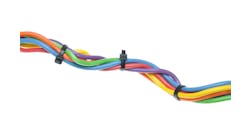VERNON HILLS, Ill. — The CC-Link Partner Association (CLPA) announced today the release of CC-Link IE Field Network, an open, 1-gigabit (Gb) Industrial Ethernet field network that, because of its speed and flexibility, offers manufacturers improved data flow, easier implementation and lowest total cost of ownership as compared to older and slower Industrial Ethernet solutions. In addition, automation equipment manufacturers can easily incorporate CC-Link IE compatibility into their products.
CC-Link IE Field Network, which is based on the IEEE 802.3 standard, provides the ultra high-speed data acquisition backbone for manufacturing process improvement, process and part traceability, equipment control and monitoring, and failure detection. CC-Link IE Field Network benefits operations by simultaneously transmitting control data, log data, and diagnostic data at high speed.
Features of the new CC-Link IE Field Network include:
- Ultrahigh speed -- One gigabit-per-second transmission and real-time protocol enables control of remote I/O field devices with essentially no transmission delay. This transmission rate is at least ten times faster than currently available Industrial Ethernet-based networks. The new network uses commercially available Cat5E cable and RJ45 connectors.
- Inherent determinism without Ethernet switches -- A significant difference between CC-Link IE Field Network and other Industrial Ethernet solutions is that CC-Link IE Field Network delivers deterministic control communications without requiring the addition of Ethernet switches. This feature eliminates the hardware costs and engineering implementation costs of those switches. Also, the cost and need for developing communication statements to govern the flow of data is eliminated due to the shared memory concept of CC-Link IE Field and no knowledge of CC-Link IE protocol is required. Determinism is guaranteed by the CC-Link IE token-passing technique.
- Flexible topology -- A CC-Link IE Field Network allows for a topology best suited to the needs of the particular application, thus ensuring greatest flexibility. These topologies include star, line, mixed star and line, and ring. Within a single network there can be a total of 254 stations with up to 328 feet (100 meters) of Cat5E cable between each station. In addition, as many as 239 networks can be interconnected allowing vast exchange of data to suit any application.
- Seamless Communication -- CC-Link IE Field networking enables seamless communication of data from field devices to controllers and from controllers to other controllers in order to form an integrated network for transmitting data at gigabit speed. An Ethernet adapter enables connection to 100-Mb Ethernet devices.
- Built-in diagnostics -- Built-in network diagnostics help to reduce total cost of ownership from installation through to operation and maintenance.
CC-Link (Control & Communication Link) is the first open technology field network from Japan/Asia. Introduced in 2000 as an open fieldbus network, CC-Link enabled the high-speed transmission and processing of control and information data to satisfy the requirements of automation control systems. In 2007, the CC-Link IE Control Network was introduced to enable 1-Gb Industrial Ethernet communications between automation controllers over fiber optic cable. Now, CC-Link IE Field networking provides 1 Gb Industrial Ethernet communications to field devices over Cat5E cable.
Approximately seven million CC-Link compatible products, manufactured by hundreds of automation equipment suppliers, have been installed. There currently are more than 1200 CLPA members (60% from outside Japan). CC-Link networking is installed in numerous industries throughout the world. These include automobile manufacturing, semiconductor/liquid crystal factories, chemical facilities, water-processing facilities, pharmaceutical manufacturing, food processing, printing facilities, building automation, and many others. CC-Link usage is greatest in Asia and offers new potential sales for North American OEMs and equipment suppliers that develop CC-Link products. In recent years, the number of CC-Link installations in the United States and Europe has increased steadily.



